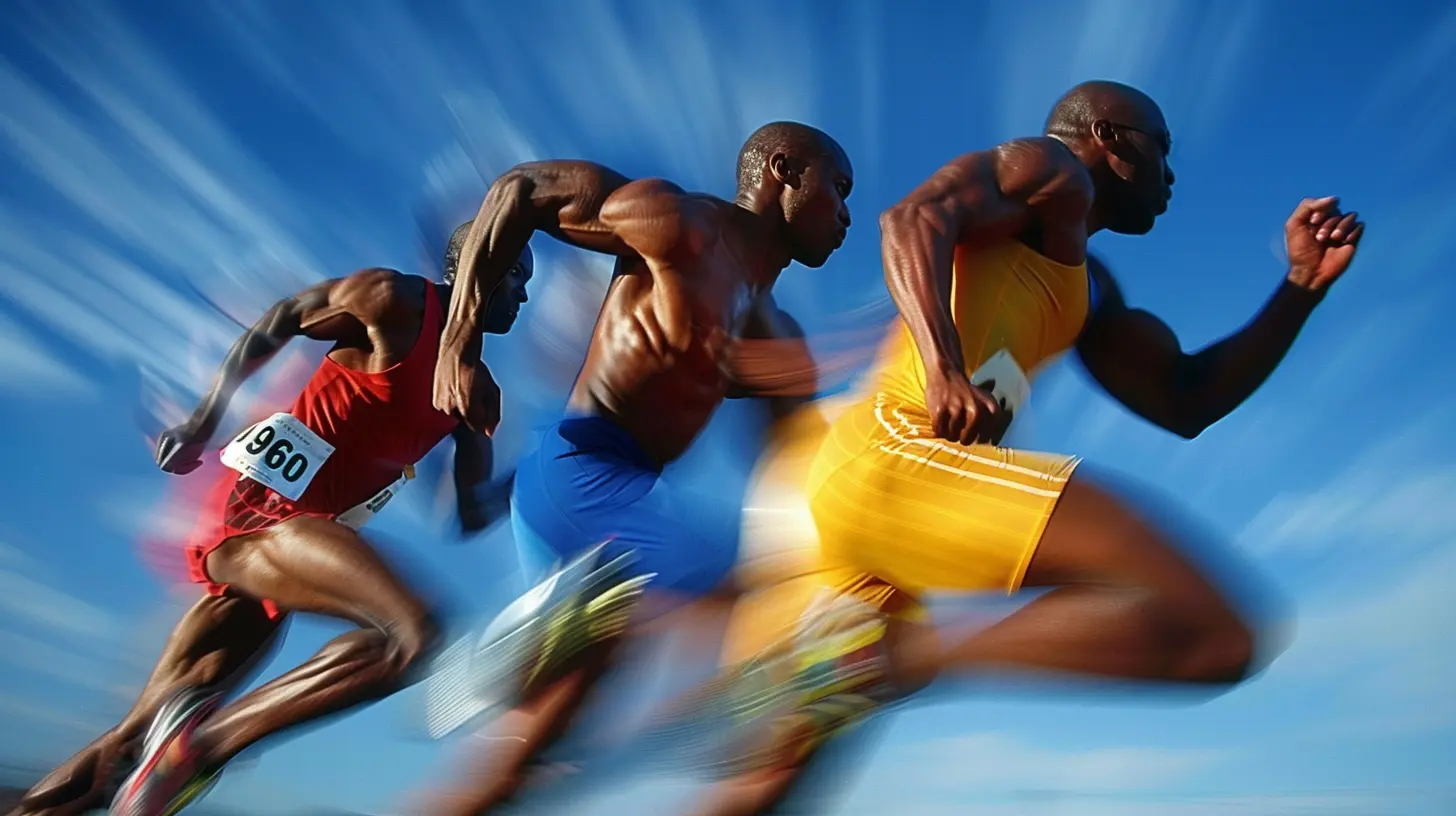The Science Behind Running: How to Boost Your Performance
16 March 2025
Running is one of the most natural forms of exercise. It’s something many of us do without thinking, whether we’re chasing after a bus or enjoying a morning jog. But have you ever stopped to consider the science behind running? Why does it sometimes feel like you’re flying with the wind, and other times like your legs are weighed down with bricks?
The truth is, there's a whole lot going on behind the scenes when you run. From the mechanics of your muscles to how your body uses energy, understanding the science behind running can not only give you an edge but also help you improve your performance. So, lace up your shoes, and let’s dive into the fascinating science of running and how you can use it to hit your next personal best.

The Mechanics of Running
Running looks deceptively simple. After all, it's just putting one foot in front of the other, right? Well, not quite. When you run, your body is orchestrating a complex symphony of movements and processes that allow you to move efficiently.The Role of Muscles and Joints
Your muscles and joints are at the heart of running. The major muscles involved include your quadriceps, hamstrings, calves, and glutes. These muscles work together, contracting and relaxing in a coordinated sequence to propel you forward.There’s also a lot happening at the joints. Your knees, hips, and ankles are essential in absorbing the impact of each step, while also allowing for the smooth transfer of energy. Think of your body as a spring: every time your foot strikes the ground, your joints compress slightly to absorb the shock, and then they spring back to help push you forward.
The Gait Cycle
When you run, you go through a process known as the gait cycle. This cycle is broken down into two main phases: the stance phase, when your foot is in contact with the ground, and the swing phase, when your foot is in the air. The key to running efficiently lies in mastering this cycle.During the stance phase, your body absorbs the impact and stores energy, which is then released during the swing phase to help propel you forward. The smoother and more efficient your gait cycle, the less energy you waste, allowing you to run longer and faster. Think of it like a well-oiled machine—when all the parts are working in harmony, everything moves more efficiently.

The Importance of Running Form
Ever notice how elite runners seem to glide across the ground effortlessly? That’s because they’ve mastered their running form. While there’s no one-size-fits-all when it comes to form, there are a few key principles that can help you improve your performance.Posture Matters
Good posture is essential for efficient running. Keep your back straight, your shoulders relaxed, and your head up. Imagine there’s a string pulling you upward from the top of your head. This helps to open up your chest, making it easier to breathe and allowing more oxygen to flow to your muscles.Arm Swing
Your arms play a more significant role in running than you might think. A proper arm swing can help you maintain balance and momentum. Keep your arms bent at a 90-degree angle and swing them naturally with your stride. Avoid crossing your arms over your body, as this can throw off your balance and waste energy.Foot Strike
How your foot strikes the ground can have a huge impact on your running efficiency. Some runners are heel strikers, meaning their heel hits the ground first, while others are forefoot or midfoot strikers. While there’s no universally “correct” foot strike, landing closer to your midfoot can reduce the impact on your joints and help you run more efficiently.
The Role of Aerobic and Anaerobic Systems
Running isn’t just about muscles and joints; it’s also about energy. When you run, your body relies on two main energy systems: the aerobic system and the anaerobic system. Understanding how these systems work can help you tailor your training to improve your performance.Aerobic System
The aerobic system is your body’s primary source of energy during long, steady runs. This system uses oxygen to convert carbohydrates and fats into energy. The aerobic system is efficient but slow, which is why it’s used during endurance activities, like long-distance running.Think of the aerobic system as your body’s long-term energy provider—it’s the marathon runner of your energy systems. If you want to boost your long-distance running performance, focus on training your aerobic system through steady-state runs and building endurance.
Anaerobic System
The anaerobic system, on the other hand, kicks in when you need a quick burst of energy, like during a sprint or when you’re running up a hill. This system doesn’t rely on oxygen; instead, it uses stored glycogen (a form of carbohydrate) for energy. The anaerobic system is fast but inefficient, producing energy quickly but also leading to the buildup of lactic acid, which causes that familiar burning sensation in your muscles.If you’re aiming to improve your speed or power, you'll want to train your anaerobic system by incorporating interval training, sprints, or hill workouts into your routine.

The Impact of Nutrition on Running Performance
You’ve probably heard the saying, “You are what you eat,” and when it comes to running, this couldn’t be more true. What you put into your body has a direct impact on your performance, both in terms of energy and recovery.Carbohydrates: Your Best Friend
Carbohydrates are your body’s preferred source of fuel when running, especially during longer efforts. When you eat carbs, your body breaks them down into glucose, which is either used immediately for energy or stored in your muscles as glycogen. Having enough glycogen stores is crucial for longer runs, as it provides the energy your body needs to keep going.If you’re preparing for a long run or race, focus on loading up on complex carbohydrates like whole grains, fruits, and vegetables in the days leading up to the event. During the run, quick-digesting carbs like energy gels or sports drinks can give you a needed boost.
Protein for Recovery
While carbohydrates fuel your run, protein is essential for helping your muscles recover afterward. Running causes tiny tears in your muscle fibers, and protein helps repair these tears, making your muscles stronger in the process. Incorporating protein-rich foods like lean meats, eggs, or plant-based options like beans and tofu into your post-run meals can speed up recovery and reduce muscle soreness.Hydration: The Game Changer
Don’t underestimate the power of hydration. When you run, you lose water through sweat, and if you don’t replace it, your performance can take a nosedive. Dehydration leads to fatigue, cramps, and even dizziness, all of which can derail your run.Make sure to drink water throughout the day, not just right before your run. If you’re going for a long run, consider bringing a water bottle or planning your route around water fountains. On hotter days or during intense workouts, you may also want to include an electrolyte drink to replenish the minerals lost through sweat.
The Power of Mental Strength in Running
Running isn’t just a physical challenge; it’s a mental one, too. In fact, many seasoned runners will tell you that running is more of a mental game than a physical one. It’s your mind that pushes you through the last mile when your legs are screaming at you to stop.Setting Goals
One of the best ways to boost your mental strength as a runner is by setting clear, achievable goals. Whether it’s running a certain distance, improving your pace, or completing a race, having a goal gives you something to focus on and work towards. Break your goal down into smaller milestones, and celebrate each one along the way. This will keep you motivated and make the end goal seem more attainable.Positive Self-Talk
Ever notice how your inner dialogue can either push you forward or hold you back? When you’re deep into a run and feeling fatigued, the way you talk to yourself matters. Instead of focusing on how tired you feel, try repeating positive affirmations like “I’ve got this” or “One step at a time.” It might sound cheesy, but research shows that positive self-talk can boost your performance by improving your mental resilience.Visualization
Another powerful mental tool is visualization. Before a race or tough workout, take a few minutes to close your eyes and imagine yourself running smoothly and confidently. Picture yourself crossing the finish line or hitting that new personal record. Visualizing success can help boost your confidence and reduce pre-race anxiety.
Rest and Recovery: The Unsung Hero
You might think that the more you run, the better you’ll get, but that’s not entirely true. In fact, rest and recovery are just as important as the miles you put in. When you rest, your body repairs and strengthens itself, making you a stronger runner in the long run.The Importance of Sleep
Sleep is the ultimate recovery tool. During sleep, your body goes into repair mode, healing muscles, replenishing energy stores, and releasing growth hormones. If you’re not getting enough sleep, you’re not giving your body the time it needs to recover, which can lead to fatigue, injury, and even burnout.Active Recovery
Rest doesn’t always mean lying on the couch (although, sometimes, that’s exactly what you need). Active recovery involves light activity, like walking, swimming, or yoga, which helps increase blood flow and reduce muscle stiffness without putting too much strain on your body.Conclusion
Running is more than just a physical activity; it’s a science. From the mechanics of your muscles and joints to the way your body uses energy, there’s a lot going on beneath the surface. By understanding the science behind running, you can make small adjustments to your form, training, and nutrition that will help you run more efficiently and boost your performance. So, the next time you hit the pavement, remember that every step you take is a finely tuned dance between body and mind.all images in this post were generated using AI tools
Category:
RunningAuthor:

Frankie Bailey
Discussion
rate this article
11 comments
Tobias Fisher
Great insights on the science of running! It's fascinating to see how understanding biomechanics and nutrition can enhance performance. Looking forward to applying these tips to improve my own training regimen. Keep up the excellent work!
April 4, 2025 at 11:01 AM

Frankie Bailey
Thank you for your thoughtful feedback! I'm glad you found the insights helpful and wish you the best in applying them to your training. Happy running!
Justice McVaney
Great article! It’s inspiring to see how science can enhance our running. Every small adjustment makes a difference—looking forward to applying these tips!
April 4, 2025 at 2:32 AM

Frankie Bailey
Thank you! I’m glad you found it inspiring. Best of luck with the tips! Happy running!
Faelith Willis
Great insights! Understanding the science of running can truly enhance performance. Incorporating proper biomechanics, nutrition, and recovery strategies will help every runner unlock their potential.
April 2, 2025 at 12:06 PM

Frankie Bailey
Thank you! I'm glad you found the insights valuable. Proper biomechanics, nutrition, and recovery are indeed crucial for maximizing running performance. Happy running!
Molly McCaffrey
This article effectively highlights the intersection of science and athleticism in running. By focusing on physiological factors, it provides actionable insights for runners. Understanding biomechanics and nutrition not only enhances performance but also promotes longevity in the sport. Great read!
April 1, 2025 at 12:36 PM

Frankie Bailey
Thank you for your positive feedback! I'm glad you found the insights on biomechanics and nutrition helpful for enhancing performance and longevity in running.
Ivy Pacheco
This article offers valuable insights into the science of running and its impact on performance. I appreciate the emphasis on understanding physiological factors and the practical tips provided. It's a great reminder that improving our running isn't just physical—it's also about mental preparation and knowledge.
March 31, 2025 at 2:48 AM

Frankie Bailey
Thank you for your thoughtful comment! I'm glad you found the insights and practical tips helpful for both physical and mental preparation in running.
Uriel Carr
Understanding biomechanics is essential for improving running performance effectively.
March 30, 2025 at 3:43 AM

Frankie Bailey
Absolutely! Understanding biomechanics allows runners to optimize their form, reduce injury risk, and enhance overall performance.
Garrett Perez
Unlock your potential! Embrace the science of running, push your limits, and watch your performance soar. You’ve got this!
March 26, 2025 at 3:43 AM

Frankie Bailey
Thank you! Embracing the science of running truly can elevate performance. Let's keep pushing those limits together!
Patricia Stewart
Understanding the science of running can transform our performance. By focusing on technique, nutrition, and recovery, we not only enhance our abilities but also foster a deeper connection to the joy of movement itself.
March 22, 2025 at 5:22 AM

Frankie Bailey
Absolutely! Mastering the science of running truly elevates our performance and appreciation for movement. Thank you for highlighting these key elements!
Pilar Jackson
This article beautifully highlights the blend of passion and science in running. Understanding the mechanics behind our strides not only enhances performance but deepens our love for the sport. Thank you for sharing these invaluable insights!
March 20, 2025 at 9:01 PM

Frankie Bailey
Thank you so much for your thoughtful comment! I'm glad you enjoyed the blend of passion and science in running. Happy running!
Alice Marks
Great article! It’s amazing how a little science can supercharge our running game. Remember, every step counts—embrace the journey, keep pushing, and let those endorphins work their magic! Happy running! 🏃♂️✨
March 19, 2025 at 1:26 PM

Frankie Bailey
Thank you for your kind words! Absolutely, every step and a bit of science can make a big difference. Happy running! 🏃♂️✨
Madison Rivera
Interesting insights; science truly motivates!
March 19, 2025 at 4:32 AM

Frankie Bailey
Thank you! I'm glad you found the insights motivating!
MORE POSTS

How Great Sports Books Go Beyond the Scoreboard

The Role of a Coach in Injury Recovery and Preventing Burnout

The Importance of Gut Health in Athletic Performance: A Scientific Perspective

Defensive Masterclass: How the Back Line Stood Strong

A Day in the Life of a Professional Wrestler

How to Deal with Windy Conditions on Your Cycling Route

The Last Hurrah: Honoring a Career Filled with Triumphs

The Role of Vision in Sports: How Athletes Train Their Eyes